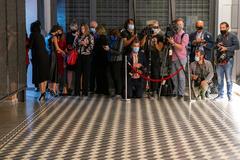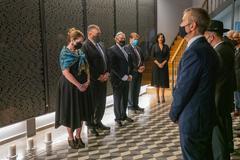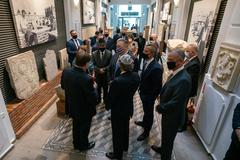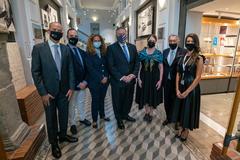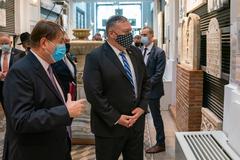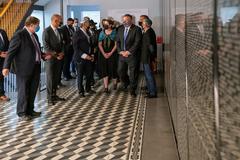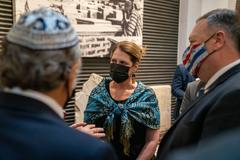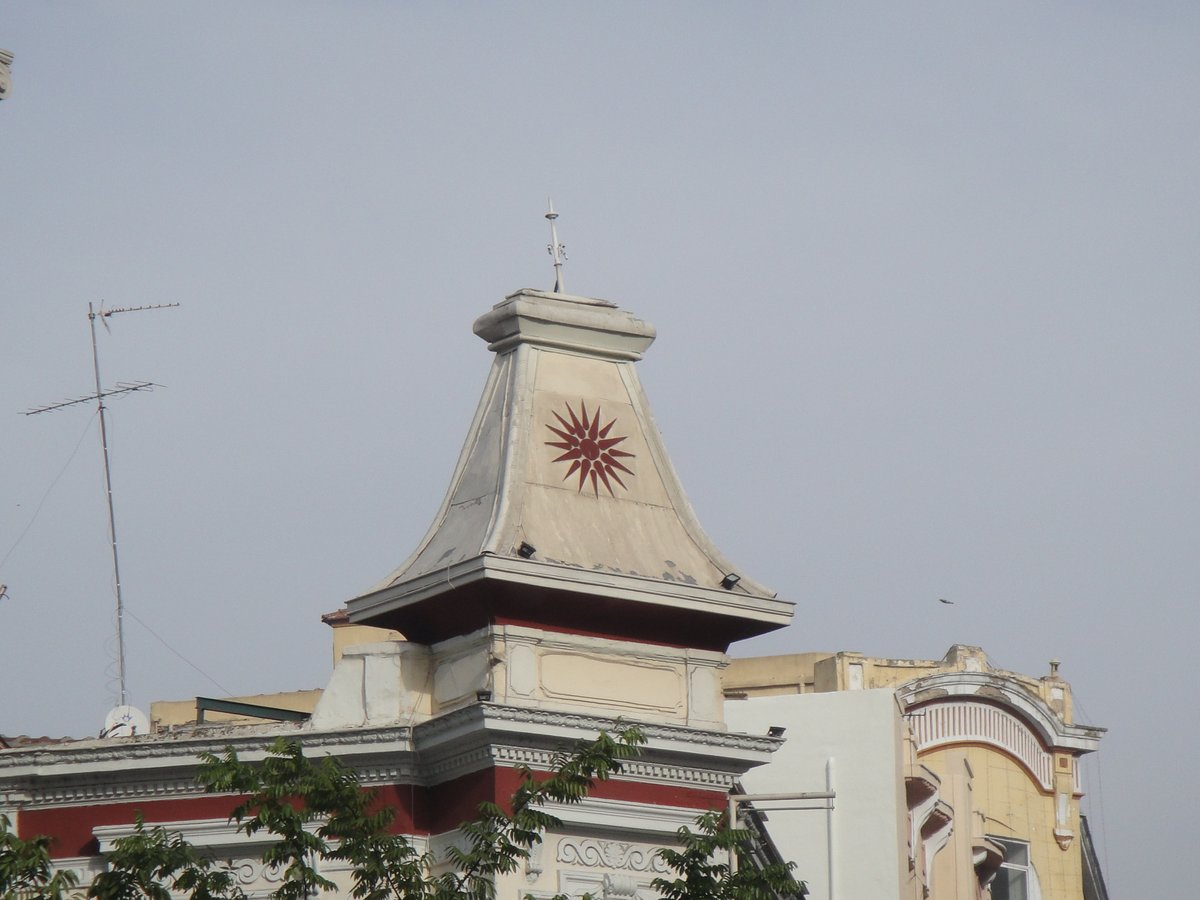
Jewish Museum of Thessaloniki: Visiting Hours, Tickets, and Guide to Thessaloniki Historical Sites
Date: 14/06/2025
Introduction
Thessaloniki, Greece, often called the “Jerusalem of the Balkans,” is renowned for its vibrant Sephardic Jewish community and centuries-old Jewish heritage. The Jewish Museum of Thessaloniki offers an immersive experience into this rich history, tracing the community’s journey from antiquity through the Holocaust to the present day. Housed in a historic neoclassical building that withstood the city’s devastating 1917 fire, the museum preserves invaluable artifacts, documents, and testimonies. This guide provides all the essential information for planning your visit—including opening hours, ticket details, accessibility, and recommendations for nearby sites—so you can make the most of your exploration of one of Europe’s most significant Jewish heritage destinations (Jewish Museum of Thessaloniki Official Website; Gil Travel; Aish.com).
Contents
- Introduction
- Early Jewish Presence in Thessaloniki
- The Sephardic Influx and Ottoman Era
- Community Life and Cultural Flourishing
- Transition to Greek Rule and Modernization
- The Holocaust and Its Impact
- Key Historical Sites and Visiting Information
- Jewish Museum of Thessaloniki
- Monastirioton Synagogue
- Holocaust Memorial
- Other Notable Sites
- Visitor Tips for Exploring Thessaloniki’s Jewish Heritage
- Jewish Museum of Thessaloniki: Visiting Hours, Tickets & Highlights
- Museum Location and Building
- Museum Layout and Exhibitions
- Ground Floor: Necropolis and Early Artifacts
- First Floor: Community Life and Flourishing
- Holocaust Memorial and Documentation
- Library and Research Facilities
- Temporary Exhibitions and Educational Programs
- Visitor Experience and Tips
- FAQ
- Conclusion
- Sources and Further Reading
Early Jewish Presence in Thessaloniki
Jewish life in Thessaloniki dates back over two millennia, with some traditions suggesting a presence since the city’s founding in 315 BCE. By the 12th century, the Jewish population was documented by Rabbi Benjamin of Tudela, who noted their involvement in silk-weaving and their recognized status under local authorities (Aish.com). This early community set the foundation for what would become a major Jewish center in the Mediterranean.
The Sephardic Influx and the Ottoman Era
A major turning point came after 1492, when Sephardic Jews expelled from Spain found refuge in Thessaloniki, then under Ottoman rule. The city’s Jewish population grew rapidly, and by the 16th century, Jews made up a significant portion of the city’s residents. The Sephardic newcomers brought their language (Ladino), customs, and commercial acumen, quickly becoming central to Thessaloniki’s economic and cultural life. At its height, the Jewish community comprised more than half the city’s population, earning Thessaloniki the title “Mother of Israel” (Aish.com).
Community Life and Cultural Flourishing
During the Ottoman period, the Jewish community enjoyed relative autonomy and developed a rich religious and cultural life. Organized around synagogues such as the Monastirioton (founded by Jews from Monastir), the community established schools, newspapers, and charitable institutions. Ladino became the community’s lingua franca, and Jewish workers were so numerous at the port that it closed on Shabbat and Jewish holidays (Aish.com).
Transition to Greek Rule and Modernization
Following the Balkan Wars, Thessaloniki became part of Greece in 1912. The transition presented both opportunities and challenges for the Jewish community, including pressures to assimilate and episodes of antisemitism. Despite this, the community continued to thrive, contributing to the city’s economic, political, and cultural life.
The Holocaust and Its Impact
World War II brought devastation to Thessaloniki’s Jews. Under Nazi occupation, approximately 49,000 Jews—over 90% of the prewar community—were deported to Auschwitz and Bergen-Belsen, where most perished (Wikipedia). The Holocaust remains a central theme of the museum, with exhibits dedicated to remembrance and education.
Key Historical Sites and Visiting Information
Jewish Museum of Thessaloniki
- Address: 13 Agiou Mina Street, Thessaloniki
- Visiting Hours: Tuesday–Sunday, 10:00 AM–5:00 PM; closed Mondays and major holidays (Jewish Museum of Thessaloniki Official Website)
- Tickets: €5 adults; discounts for students, seniors, groups; free for children under 6 and on certain commemorative days.
- Highlights: Extensive exhibits on Jewish history, culture, and the Holocaust; library and research facilities; educational programs.
Monastirioton Synagogue
- The oldest functioning synagogue in Thessaloniki, significant for its architecture and history.
- Tours available by appointment through the Jewish Community of Thessaloniki.
Holocaust Memorial
- Located near Eleftherias Square, this monument commemorates the city’s Holocaust victims and is open to the public at all times.
Other Notable Sites
- Etz Hayyim Synagogue: Still active with limited visiting hours.
- Historic Jewish Cemetery Site: Once the largest in Greece, with some surviving monuments viewable by guided tour.
- Jewish Quarter of Ladadika: A district rich with Jewish history and architecture.
Visitor Tips for Exploring Thessaloniki’s Jewish Heritage
- Best Times to Visit: Spring (April–June) and autumn (September–October) for pleasant weather.
- Accessibility: The museum and most major sites are wheelchair accessible; check ahead for specific requirements.
- Guided Tours: Available through the museum and local tour operators; advance booking recommended.
- Photography: Allowed in most museum areas; however, follow posted guidelines and restrictions.
Jewish Museum of Thessaloniki: Visiting Hours, Tickets & Highlights
Museum Location and Building
The museum is housed in a neoclassical building from 1906, one of the few Jewish structures to survive the 1917 fire. It previously served as the Bank of Athens and housed the French-language Jewish newspaper “L’Indépendant,” reflecting the community’s prominence (Greece Is; InThessaloniki).
Museum Layout and Exhibitions
Ground Floor: Necropolis and Early Artifacts
Commemorates Thessaloniki’s destroyed Jewish cemetery with tombstones, inscriptions in Hebrew, Ladino, and Greek, and ritual objects from synagogues lost during WWII.
First Floor: Community Life and Flourishing
Features business licenses, correspondence, textiles, religious items, ketubot (marriage contracts), and cultural artifacts highlighting daily and ceremonial life.
Holocaust Memorial and Documentation
A moving section dedicated to the Shoah, displaying original documents, identity cards, yellow stars, deportation orders, and survivor testimonies. The Memorial Wall honors the names and stories of the victims (Greece Is).
Library and Research Facilities
Hosts rare books, periodicals, and archives on Jewish and Sephardic history, open to researchers and visitors (WhichMuseum).
Temporary Exhibitions and Educational Programs
The museum regularly organizes exhibitions on Jewish art, Sephardic music, and multicultural relations, alongside educational workshops and guided tours (JGuide Europe).
Visitor Experience and Tips
- Photography Policy: Generally permitted, but restrictions apply in certain areas—check signage.
- Gift Shop: Offers books and memorabilia related to Thessaloniki’s Jewish heritage.
- Best Times: Weekday mornings are least crowded.
- Nearby Attractions: Combine your visit with the Monastirioton Synagogue and walks through the Ladadika district.
Frequently Asked Questions (FAQ)
Q: What are the museum’s visiting hours?
A: Tuesday–Sunday, 10:00 AM–5:00 PM; closed Mondays and major holidays (Jewish Museum of Thessaloniki Official Website).
Q: How much do tickets cost?
A: General admission is approximately €5; discounts apply for students, seniors, and groups.
Q: Is the museum wheelchair accessible?
A: Yes, with ramps and elevators.
Q: Are guided tours available?
A: Yes, in multiple languages by appointment.
Q: Can I take photographs inside the museum?
A: In most areas, yes—check for posted restrictions.
Q: How do I get there?
A: Located at 13 Agiou Mina Street, easily accessible by public transport and within walking distance of central Thessaloniki.
Conclusion
The Jewish Museum of Thessaloniki stands as a testament to the city’s vibrant Jewish legacy, offering a compelling journey through centuries of history, culture, and resilience. With its meticulously curated exhibits, educational programs, and inclusive approach, the museum is a must-visit for anyone interested in Thessaloniki’s multicultural heritage. Combine your visit with nearby sites like the Monastirioton Synagogue and Holocaust Memorial for a comprehensive experience. For the latest updates, events, and guided tour options, visit the museum’s official website and consider downloading the Audiala app.
Sources and Further Reading
- Jewish Museum of Thessaloniki Official Website
- Gil Travel: Jewish Heritage in Thessaloniki
- Aish.com: Jewish History of Thessaloniki (Salonika)
- Greece Is: 10 Stops Jewish Thessaloniki
- InThessaloniki: Jewish Museum of Thessaloniki
- Wikipedia: Jewish Museum of Thessaloniki
- WhichMuseum: Jewish Museum of Thessaloniki
- JGuide Europe: Thessaloniki

